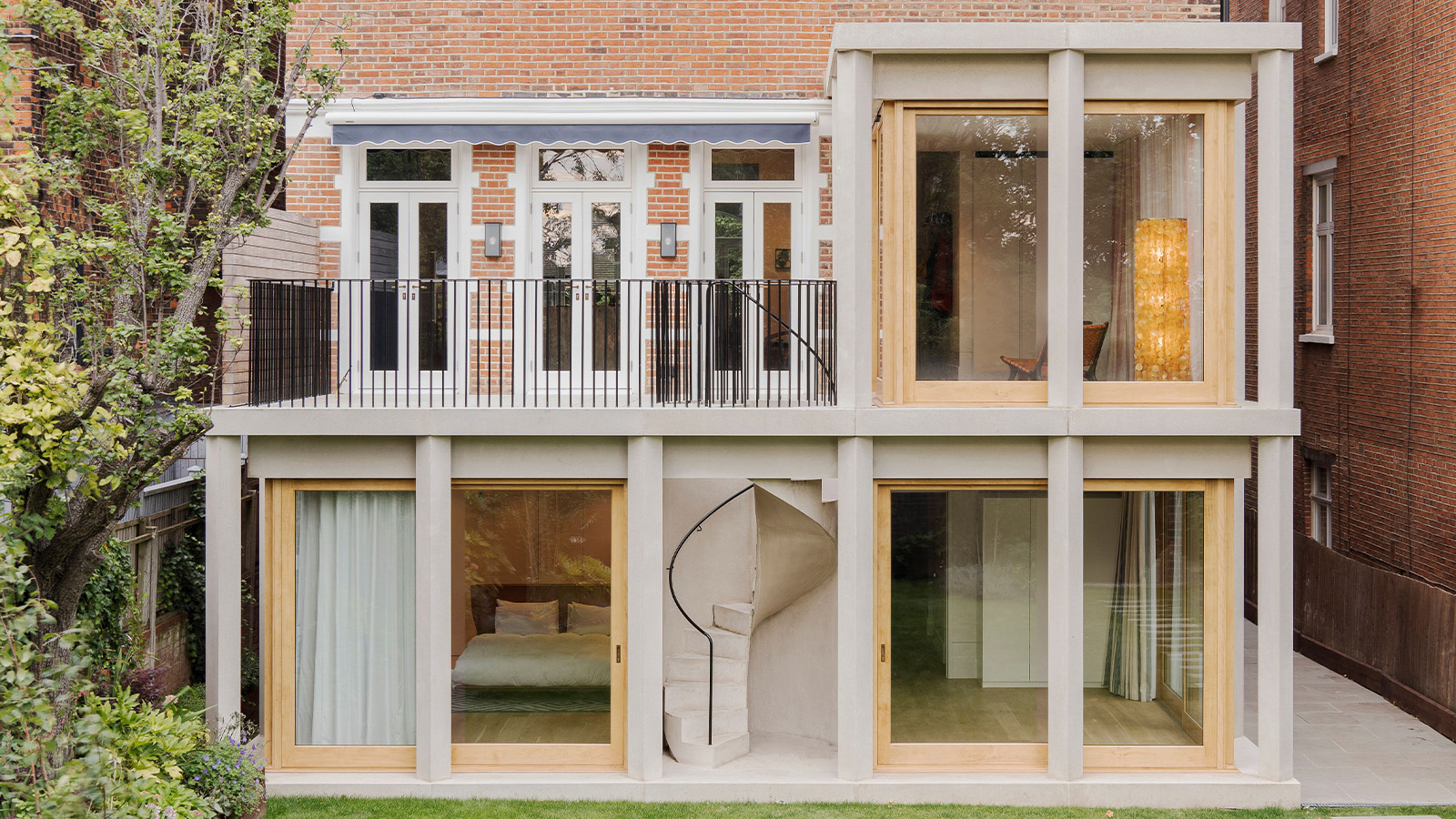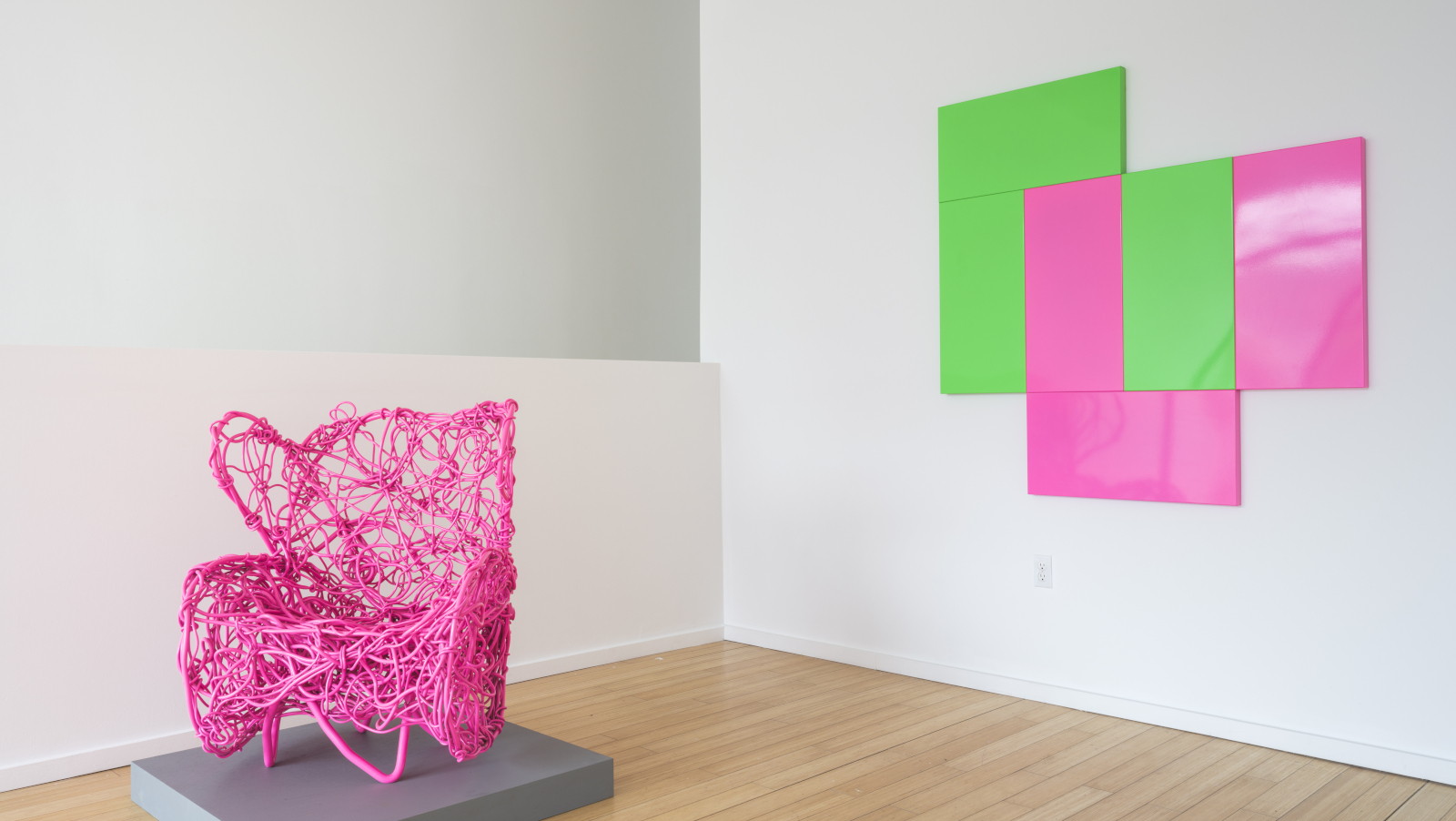Inside Stefan Brüggemann’s epic new studio and residency in Ibiza
Stefan Brüggemann’s new Ibiza studio and retreat doesn’t miss a beat. The artist offers us an exclusive look at his creative utopia, designed by Alberto Kalach and realised by Iván Torres Arquitectos

Stefan Brüggemann’s incisive artworks draw on the political punch of street art, the freedom of punk music, and the clean lines of minimalism. The Mexican artist is now opening a studio and residency space in Ibiza, on a 30,000 sq m plot situated in the centre of the island. Working with his compatriot, architect Alberto Kalach – alongside local practice Iván Torres Arquitectos, which developed and executed the latter’s concept – Brüggemann has brought his genre-defying approach to the project, which comprises a pavilion with domestic, studio and exhibition uses, a botanical garden, and a pool designed to fit seamlessly into the natural environment. It is a place for Brüggemann to live and work between studios in London and Mexico City, and to host a lively residency programme for poets, novelists and fellow artists.
‘A friend of mine was interested in buying the plot of land and, for some reason, he didn’t go for it. I thought, “Why not?”’ he says when we meet at his east London studio, where gold leaf and spray-paint works line the walls, and towering plants cover the mezzanine. ‘I was thinking about what it means to be a contemporary artist. I didn’t want a warehouse with 100 assistants, or a factory. That sounds very 1980s New York.

Featuring concrete block walls, the studio is the first European project of Mexican architect Alberto Kalach

The circular swimming pool at Brüggemann’s new studio, built on a 30,000 sq m plot in the centre of Ibiza
‘During my research, I found stories about German philosopher Walter Benjamin coming to Ibiza during the Second World War. It reads like the romantic story of an island. It’s a place you might go if you’re heartbroken or trying to figure out your place in the world. That gave me the idea of a residency for writers and artists, surrounded by nature. It’s a place where I can work, live and invite people to be part of discussions. It’s a place to explore ideas,’ he says.
This is the first European project for Kalach, whose practice is based in Mexico City. The building stands in stark contrast to the white mansions that puncture Ibiza’s hills. Formed from utilitarian concrete blocks, the structure is surrounded by plants and bright red sand. Inside the main living space, the gold leaf-clad walls are covered with the artist’s text works. A soundtrack of friend and collaborator Iggy Pop reading Brüggemann’s text plays in the background. The floor is made of recinto, a Mexican volcanic stone formed from solidified lava. Black burned yakisugi wood features heavily throughout the pavilion and veranda roof.

Brüggemann in his new Ibiza studio, where he hopes to welcome other artists and creatives
Brüggemann shared an initial brief with Kalach, and says little changed in the architect’s drawings. Kalach saw his role as choreographing the artist’s idea of bringing art, architecture, sound and nature together harmoniously. ‘I didn’t want the house of a football player,’ Brüggemann explains. ‘He did something really exciting with simple materials, light and space.’
A circular pool situated close to the main building takes on the appearance of a natural pond, surrounded by layered banks of plants. It is cone-shaped rather than cylindrical, allowing distance to swim but saving water capacity. ‘I moved all this earth around the pool so that there is more height,’ he tells me. ‘My idea was that when you’re inside, there are all these layers of colours. The idea is that you can go inside and be immersed in nature as if you are in a river.’
The garden has provided a surprising creative venture for Brüggemann. ‘My work is about immediacy. I grasp the moment. With nature, it’s the other way around. It has been an exercise in giving up control. You can kill a plant by trying to accelerate it. I think the garden is an artwork. I have started around the pool and will keep extending outwards. Maybe I will become a worse artist and a better gardener,’ he laughs.
Wallpaper* Newsletter
Receive our daily digest of inspiration, escapism and design stories from around the world direct to your inbox.

Brüggemann, a keen gardener, worked on the landscape design, planting silvery-grey silky eremophila shrubs around the swimming pool
It’s a busy year for Brüggemann. In spring, he opened his first UK institutional exhibition ‘Not Black, Not White, Silver’ at Mostyn in Wales. The show features his ongoing series of Headlines and Last Lines in Movies: paintings overlaying news headlines with the final sentences uttered in classic films to a point of near illegibility. These pieces speak to the cacophony of information overload in the 21st century. ‘The details might change but the conflicts stay the same,’ he says. ‘It’s money, sex, loyalty, religion. I’m not making a point about the specific noise that we have, it’s about the noise itself. The political act is showing it as it is.’
Later this year, Brüggemann has shows opening at Hauser & Wirth in Los Angeles and the National Museum of Art in Mexico City: sites of political and personal resonance that the artist has previously confronted (in 2020, he installed a double-sided red, white and blue neon work spelling the word ‘LIE’ on the US/Mexico border). Asked if his work reads differently when he exhibits in these cities, he says: ‘If something happens in the US, it affects everybody. They have a position of global power. The Los Angeles show is more politically charged. Most of the conflicts and narratives I talk about are happening there. The show in Mexico City is going to be more specific. That is about Mexican legacy. I grew up with lots of great street art happening in Mexico and unconsciously understand that the work comes from there. I am doing that in a more contemporary way.’

A cross-shaped slit window illuminates the staircase, which leads to a large roof terrace
Brüggemann’s approach to art making, fluidly mixing elements from minimalism, street art, conceptualism and other art forms can be seen throughout his career. ‘My reason [for coming] to London was music related,’ he says. ‘I got to hang around [punk impresario] Malcolm McLaren for the last few years of his life. He understood all the different disciplines, art, music, politics, on the same level.’ This has had an enduring influence on Brüggemann’s work. ‘Malcolm’s whole idea with the Sex Pistols was taking these guys who couldn’t dance or sing and putting them together because they had a great attitude,’ he considers, linking these ideas with his vision for the Ibiza studio, and his work more broadly. ‘The garden was a little bit like that for me. It’s also like that with painting. It’s not a great skill, [like] life drawing. It’s the way you activate it, the compositions you create, that make it unique.’

The dining room, with a ‘Brutal’ dining table by Habitación 116 in sandblasted stone, 1977 ‘Kentucky’ dining chairs, in leather and walnut, by Carlo Scarpa for Bernini, a 2020 Fredrikson Stallard steel console, and 1960s ‘Safari’ armchairs by Arne Norell. On the wall is Brüggemann’s gold leaf and vinyl letter installation Hyper-palimpsest, 2022
See more of Stefan Brüggemann’s new Ibiza studio in the June 2023 Travel Issue of Wallpaper*, on newsstands and available to subscribers from 11 May 2023.
‘Not Black, Not White, Silver’ is on show until 17 June at Mostyn, Wales, mostyn.org. ‘White Noise’ is on show from 14 September at Hauser & Wirth LA, hauserwirth.com, stefanbruggemann.com
Emily Steer is a London-based culture journalist and former editor of Elephant. She has written for titles including AnOther, BBC Culture, the Financial Times, and Frieze.
-
 Tee time! Five golf watches to lower that handicap
Tee time! Five golf watches to lower that handicapGolf watches are smarter than ever. Here are five of the best
By Thor Svaboe
-
 Wallpaper* checks in at Treehouse Hotel Manchester: you may not want to leaf
Wallpaper* checks in at Treehouse Hotel Manchester: you may not want to leafTreehouse Hotel Manchester offers a nature-infused biophilic sanctuary amidst the city’s ever-growing architectural canopy
By Imogen Green
-
 This 19th-century Hampstead house has a raw concrete staircase at its heart
This 19th-century Hampstead house has a raw concrete staircase at its heartThis Hampstead house, designed by Pinzauer and titled Maresfield Gardens, is a London home blending new design and traditional details
By Tianna Williams
-
 Ibiza is the new hotspot for contemporary art
Ibiza is the new hotspot for contemporary artGathering Ibiza opens, a Balearic outpost of the London gallery, as founder Alex Flick hails the island’s emerging contemporary art scene
By Emily Steer
-
 Edinburgh Art Festival 2023: from bog dancing to binge drinking
Edinburgh Art Festival 2023: from bog dancing to binge drinkingWhat to see at Edinburgh Art Festival 2023, championing women and queer artists, whether exploring Scottish bogland on film or casting hedonism in ceramic
By Amah-Rose Abrams
-
 Last chance to see: Devon Turnbull’s ‘HiFi Listening Room Dream No. 1’ at Lisson Gallery, London
Last chance to see: Devon Turnbull’s ‘HiFi Listening Room Dream No. 1’ at Lisson Gallery, LondonDevon Turnbull/OJAS’ handmade sound system matches minimalist aesthetics with a profound audiophonic experience – he tells us more
By Jorinde Croese
-
 Hospital Rooms and Hauser & Wirth unite for a sensorial London exhibition and auction
Hospital Rooms and Hauser & Wirth unite for a sensorial London exhibition and auctionHospital Rooms and Hauser & Wirth are working together to raise money for arts and mental health charities
By Hannah Silver
-
 ‘These Americans’: Will Vogt documents the USA’s rich at play
‘These Americans’: Will Vogt documents the USA’s rich at playWill Vogt’s photo book ‘These Americans’ is a deep dive into a world of privilege and excess, spanning 1969 to 1996
By Sophie Gladstone
-
 Brian Eno extends his ambient realms with these environment-altering sculptures
Brian Eno extends his ambient realms with these environment-altering sculpturesBrian Eno exhibits his new light box sculptures in London, alongside a unique speaker and iconic works by the late American light artist Dan Flavin
By Jonathan Bell
-
![The Bagri Foundation Commission: Asim Waqif, वेणु [Venu], 2023. Courtesy of the artist. Photo © Jo Underhill. exterior](https://cdn.mos.cms.futurecdn.net/QgFpUHisSVxoTW6BbkC6nS.jpg) Asim Waqif creates dense bamboo display at the Hayward in London
Asim Waqif creates dense bamboo display at the Hayward in LondonThe Bagri Foundation Commission, Asim Waqif’s वेणु [Venu], opens at the Hayward Gallery in London
By Cleo Roberts-Komireddi
-
 Forrest Myers is off the wall at Catskill Art Space this summer
Forrest Myers is off the wall at Catskill Art Space this summerForrest ‘Frosty’ Myers makes his mark at Catskill Art Space, NY, celebrating 50 years of his monumental Manhattan installation, The Wall
By Pei-Ru Keh